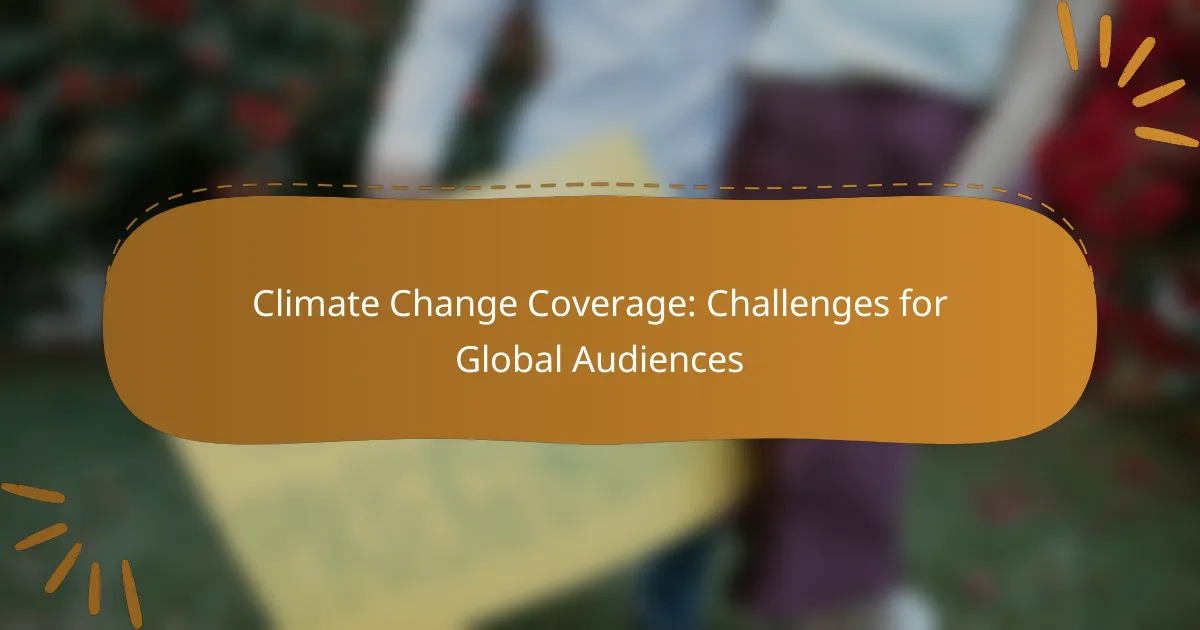Climate change presents significant challenges for global audiences, manifesting in extreme weather events, rising sea levels, and threats to food security and health. Addressing these issues requires coordinated efforts and sustainable practices, including the transition to renewable energy and improved public transportation. Governments are pivotal in this response, shaping policies and engaging in international agreements to help communities adapt and mitigate the impacts of climate change.
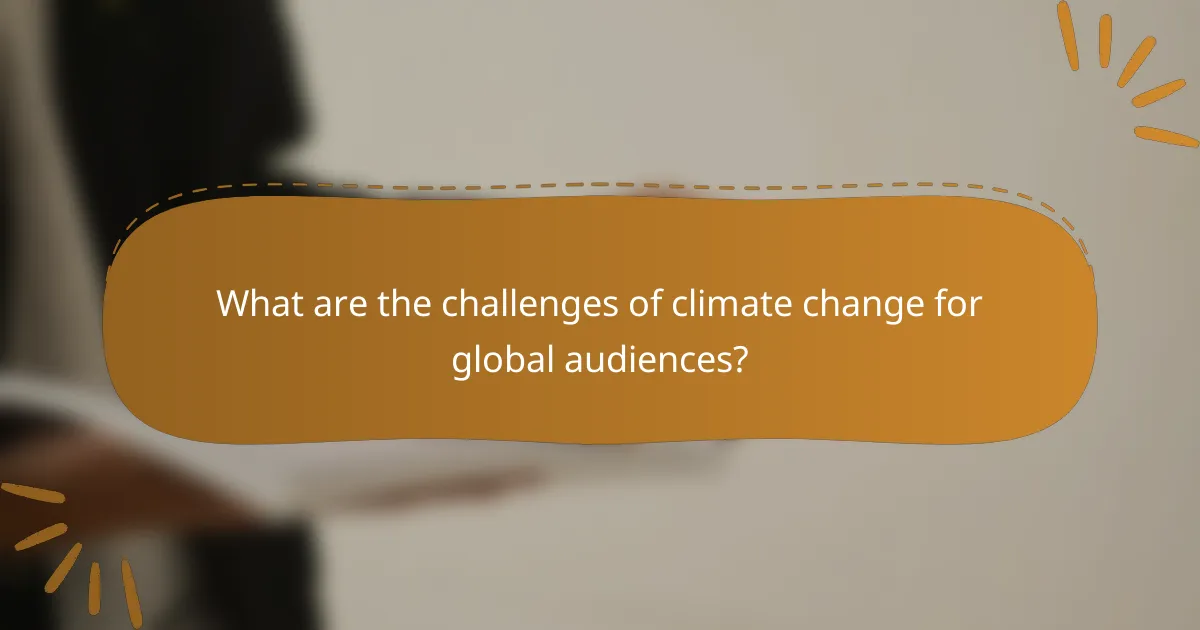
What are the challenges of climate change for global audiences?
Global audiences face numerous challenges due to climate change, including extreme weather events, rising sea levels, food security issues, health risks, and economic impacts. These challenges vary by region and require coordinated responses to mitigate their effects.
Increased extreme weather events
Climate change leads to more frequent and severe extreme weather events, such as hurricanes, floods, and droughts. These events can disrupt communities, damage infrastructure, and displace populations, particularly in vulnerable regions.
For example, areas prone to hurricanes may experience stronger storms, while regions that rely on consistent rainfall may face prolonged droughts. Understanding local climate patterns is crucial for preparedness and response strategies.
Rising sea levels
Rising sea levels, driven by melting ice caps and thermal expansion of seawater, pose a significant threat to coastal communities. Many cities worldwide are at risk of flooding, which can lead to loss of property and habitat.
In low-lying areas, even a small rise in sea level can result in increased flooding during storms and high tides. Communities must consider investing in flood defenses and adapting land use to mitigate these risks.
Food security issues
Climate change impacts agricultural productivity, leading to food security challenges. Changes in temperature and precipitation patterns can affect crop yields, making it harder to produce sufficient food for growing populations.
Regions that depend heavily on agriculture may need to adopt new farming practices or crop varieties to adapt to changing conditions. Ensuring access to food and nutrition becomes increasingly critical as climate-related disruptions occur.
Health risks
Health risks associated with climate change include increased respiratory issues from poor air quality, heat-related illnesses, and the spread of vector-borne diseases. Vulnerable populations, such as the elderly and those with pre-existing conditions, are particularly at risk.
Communities should prioritize public health initiatives that address these risks, including improving air quality and enhancing healthcare access during extreme weather events.
Economic impacts
The economic impacts of climate change are profound, affecting industries such as agriculture, tourism, and insurance. Businesses may face increased costs due to damage from extreme weather and the need to adapt to new regulations.
Investing in sustainable practices can help mitigate these economic impacts. Companies that proactively address climate risks may find new opportunities in emerging markets focused on sustainability and resilience.
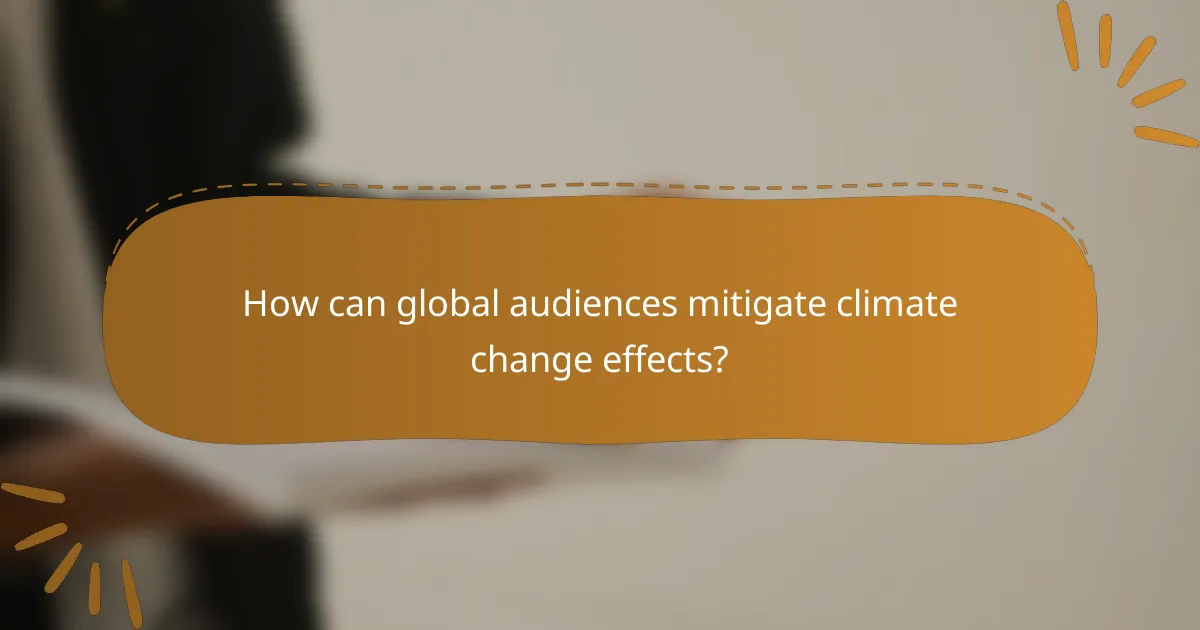
How can global audiences mitigate climate change effects?
Global audiences can mitigate climate change effects by adopting sustainable practices that reduce carbon emissions and enhance environmental resilience. Key strategies include transitioning to renewable energy, implementing sustainable agriculture, improving public transportation, and participating in carbon offset programs.
Adopting renewable energy sources
Transitioning to renewable energy sources, such as solar, wind, and hydroelectric power, is crucial for reducing reliance on fossil fuels. Individuals and communities can install solar panels or support local wind farms to decrease their carbon footprint.
Consider government incentives or subsidies that may be available for renewable energy installations, which can significantly lower initial costs. Additionally, purchasing energy from green suppliers can further support the shift towards sustainable energy.
Implementing sustainable agriculture practices
Sustainable agriculture practices, such as crop rotation, organic farming, and reduced pesticide use, help maintain soil health and reduce greenhouse gas emissions. Farmers can adopt these methods to enhance biodiversity and improve resilience against climate impacts.
Consumers can support sustainable agriculture by purchasing locally sourced and organic products, which often have a lower carbon footprint compared to conventionally farmed goods. Joining community-supported agriculture (CSA) programs can also strengthen local food systems.
Enhancing public transportation
Improving public transportation systems reduces the number of vehicles on the road, thereby lowering emissions. Cities can invest in efficient bus and train networks, making them more accessible and appealing to residents.
Using public transport, carpooling, or biking can significantly decrease individual carbon footprints. Advocating for better infrastructure, such as bike lanes and pedestrian paths, encourages more sustainable commuting options.
Participating in carbon offset programs
Carbon offset programs allow individuals and businesses to compensate for their emissions by investing in projects that reduce greenhouse gases, such as reforestation or renewable energy initiatives. This approach can help balance out unavoidable emissions from activities like travel or energy consumption.
When selecting a carbon offset program, look for verified projects that provide transparency and measurable impacts. Many organizations offer easy online platforms to calculate and offset your carbon footprint effectively.
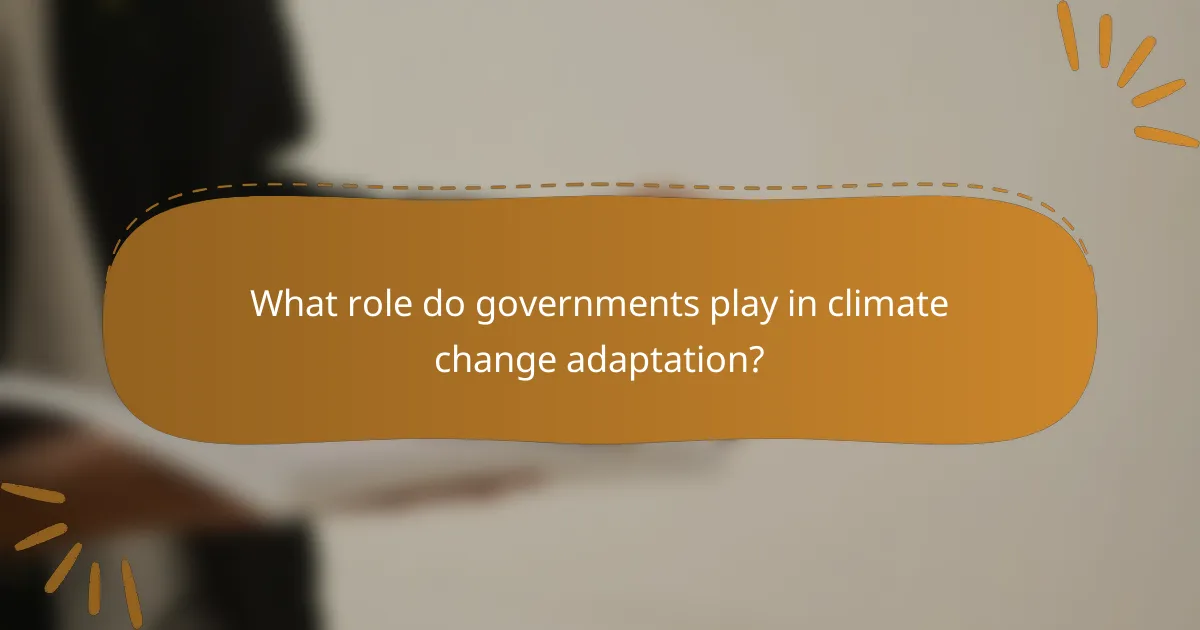
What role do governments play in climate change adaptation?
Governments play a crucial role in climate change adaptation by creating policies, funding projects, and engaging in international agreements. Their actions can significantly influence how communities prepare for and respond to climate impacts.
Policy development and regulation
Governments are responsible for developing policies that guide climate adaptation efforts. This includes setting regulations that promote sustainable practices, such as building codes that enhance resilience to extreme weather events.
Effective policy development often involves stakeholder engagement, ensuring that local communities have a voice in the decision-making process. This can lead to more tailored and effective adaptation strategies that reflect the unique needs of different regions.
Funding climate resilience projects
Funding is essential for implementing climate resilience projects, which can range from infrastructure improvements to community education programs. Governments typically allocate budgets for these initiatives, often in the millions or billions of dollars, depending on the scale of the project.
Public-private partnerships can enhance funding opportunities, allowing governments to leverage private investment for climate adaptation. Additionally, grants and subsidies can support local governments and organizations in executing their resilience plans.
International cooperation agreements
International cooperation agreements are vital for addressing climate change on a global scale. Governments participate in treaties and accords, such as the Paris Agreement, which aim to unify efforts in reducing greenhouse gas emissions and enhancing adaptation strategies.
These agreements often include commitments to share technology, funding, and best practices, enabling countries to learn from each other’s experiences. Collaborative efforts can lead to more robust adaptation frameworks that benefit multiple nations, especially those most vulnerable to climate impacts.
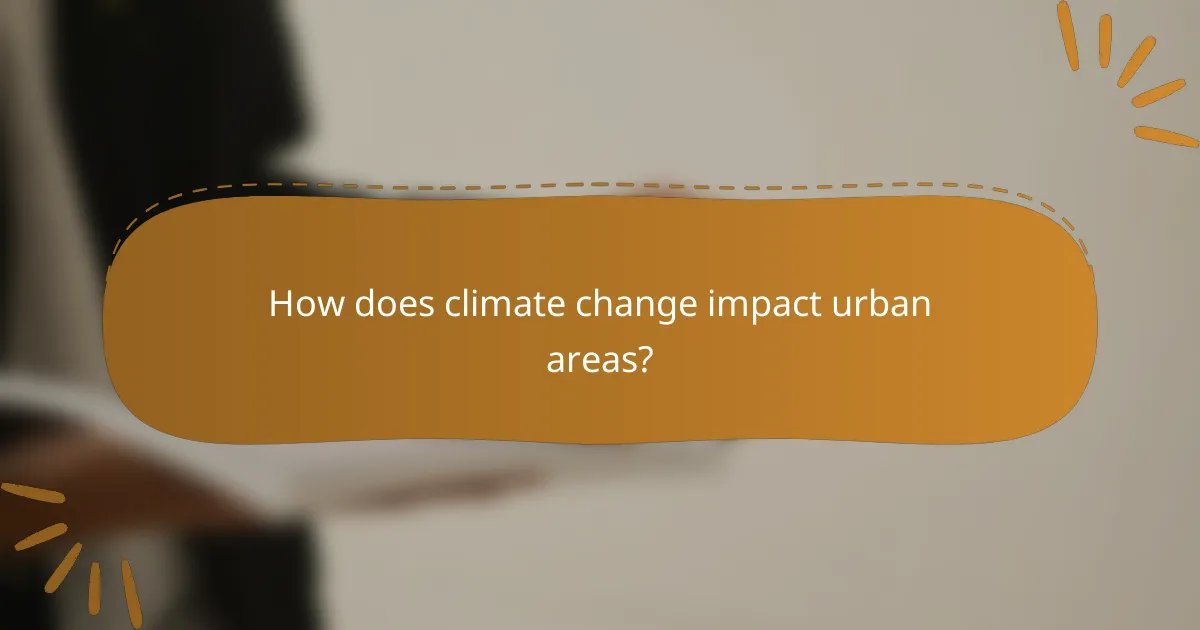
How does climate change impact urban areas?
Climate change significantly affects urban areas by increasing the frequency and intensity of extreme weather events, leading to various challenges such as flooding, heat accumulation, and strain on infrastructure. These impacts require cities to adapt and implement strategies to mitigate risks and enhance resilience.
Increased urban flooding
Urban flooding is becoming more common due to climate change, as rising sea levels and intense rainfall events overwhelm drainage systems. Cities with inadequate infrastructure are particularly vulnerable, resulting in property damage and disruption of services.
To combat flooding, urban planners should invest in green infrastructure, such as permeable pavements and green roofs, which can absorb excess rainwater. Implementing effective stormwater management systems is also crucial to reduce flooding risks.
Heat island effect
The heat island effect occurs when urban areas experience higher temperatures than their rural surroundings, primarily due to human activities and infrastructure. This phenomenon is exacerbated by climate change, leading to increased energy consumption and health risks for residents.
To mitigate the heat island effect, cities can increase vegetation through urban forestry and parks, which provide shade and cooling. Additionally, reflective building materials and green roofs can help lower surface temperatures and improve overall urban climate resilience.
Infrastructure strain
Climate change places significant strain on urban infrastructure, including transportation, water supply, and energy systems. Increased temperatures and extreme weather can lead to accelerated wear and tear, necessitating more frequent repairs and upgrades.
City officials should prioritize infrastructure assessments and invest in climate-resilient designs. Regular maintenance and updates to existing systems can help ensure they can withstand the impacts of climate change, ultimately saving costs in the long run.

What are the psychological effects of climate change on communities?
The psychological effects of climate change on communities can be profound, leading to increased anxiety, stress, and feelings of helplessness. These mental health challenges arise from the direct impacts of climate events and the broader existential threats posed by ongoing environmental changes.
Eco-anxiety among youth
Eco-anxiety is a growing concern among young people, manifesting as chronic worry about the future of the planet. Many youths feel overwhelmed by the severity of climate change, leading to feelings of despair and helplessness.
To address eco-anxiety, communities can foster open discussions about climate issues, encouraging youth to express their feelings. Engaging in local environmental initiatives can empower young individuals, helping them feel more connected and proactive in combating climate change.
Community displacement stress
Community displacement stress occurs when populations are forced to relocate due to climate-related events like flooding or wildfires. This stress can lead to a loss of social networks, cultural identity, and economic stability.
To mitigate the effects of displacement, it is crucial for local governments to provide support systems, including mental health resources and community rebuilding programs. Creating resilient infrastructure and planning for climate adaptation can also help communities better cope with potential relocations.

How can technology aid in climate change solutions?
Technology plays a crucial role in addressing climate change by providing innovative tools and methods to reduce emissions, enhance energy efficiency, and promote sustainable practices. From renewable energy systems to data analytics, technology can significantly contribute to global efforts in mitigating climate impacts.
Renewable energy innovations
Renewable energy technologies, such as solar, wind, and hydroelectric power, are essential in reducing reliance on fossil fuels. These innovations harness natural resources to generate electricity with minimal environmental impact. For instance, solar panels can convert sunlight into energy, while wind turbines can generate power from air currents.
Investment in renewable energy is increasing, with many countries setting ambitious targets for transitioning to greener energy sources. For example, the European Union aims to achieve at least 32% of its energy from renewables by 2030, promoting cleaner alternatives and reducing greenhouse gas emissions.
Smart technologies for efficiency
Smart technologies, including smart grids and energy-efficient appliances, enhance energy management and reduce consumption. Smart grids allow for real-time monitoring and optimization of energy distribution, minimizing waste and improving reliability. Energy-efficient appliances, such as LED lighting and Energy Star-rated devices, consume less power while providing the same level of service.
Adopting smart technologies can lead to significant cost savings and lower energy bills for consumers. For example, households using smart thermostats can reduce heating and cooling costs by up to 10-15% annually.
Data analytics and climate modeling
Data analytics and climate modeling are vital for understanding climate patterns and predicting future changes. By analyzing large datasets, scientists can identify trends, assess risks, and develop strategies to mitigate climate impacts. Tools like Geographic Information Systems (GIS) help visualize data and inform decision-making.
Organizations can utilize data analytics to track emissions and optimize resource use. For instance, companies can analyze their supply chains to identify inefficiencies and implement more sustainable practices, ultimately reducing their carbon footprint.
Challenges and considerations
While technology offers promising solutions, challenges remain in implementation and accessibility. High initial costs, technological disparities between regions, and the need for skilled personnel can hinder progress. Ensuring equitable access to technology, especially in developing countries, is crucial for global climate efforts.
Moreover, reliance on technology must be balanced with policy measures and community engagement. Governments and organizations should work together to create supportive frameworks that encourage innovation while addressing social and environmental concerns.
